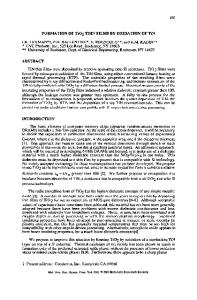Photocatalysis of Columnar TiO 2 Thin Films
- PDF / 356,616 Bytes
- 6 Pages / 612 x 792 pts (letter) Page_size
- 86 Downloads / 388 Views
KK8.7.1
Photocatalysis of Columnar TiO2 Thin Films Motofumi Suzuki, Kazuaki Kishimoto, Wataru Maekita, Kaoru Nakajima and Kenji Kimura Department of Engineering Science and Mechanics, Kyoto University, Kyoto 606-8501, JAPAN ABSTRACT Photocatalysis of oblique columnar TiO 2 thin films has been investigated as a function of thickness using photobleaching of methylene blue (MB). The degradation rate of MB depends on the thickness of the films, although no significant differences in the columnar morphology, crystallinity and optical absorption are found. The relation between the degradation rate and the thickness is well described by a simple model, in which the degradation rate at a certain depth is proportional to the intensity of ultra violet (UV) light. The photocatalytic active thickness is estimated at approximately 200 nm. Thus the interior surface of the oblique columnar TiO 2 thin films works well as photocatalyst. INTRODUCTION Unique structures and properties of obliquely deposited thin films have been extensively investigated since the end of the 1950s, while the history of the studies of obliquely deposited thin films is more than a century [1]. The oblique columnar thin films include a lot of voids, and the spacing between the columns separated by these voids depends on the in-plane direction. Not only electric, magnetic and optical [2–4] but also chemical, medical and biological applications of thin films with columnar structures are expected [5]. In particular, high porosity and the large surface area of columnar structures seem suitable for the chemical applications. In fact, we have reported the enhanced photocatalytic efficiency of TiO2 thin films with various shaped columns such as zigzag, cylinder, and helix [6]. The optimum morphology for photocatalysis has been obtained at the deposition angle α ∼ 70 ◦ , where the photocatalytic efficiency is 2.5 times larger than that at α = 0 ◦ . However, the photocatalytic efficiency decreases for the thin films with the unique shaped isolated columns prepared at α ≥ 75 ◦ . In addition, the shape of the columns such as zigzag, cylinder, and helix is less important for the photocatalytic efficiency. We have attributed these behaviors to the dependence of the effective surface area on α and the shapes based on the simulation results using our thin film growth simulator vfigs [7]. Although the oblique columnar structures are quite effective for the photocatalyst, photocatalytic reaction may occur at shallow region of the films since it requires the irradiation of ultra violet (UV) light. Therefore, it is important to evaluate the active region of the photocatalytic TiO2 columnar films in order to optimize the morphology. In this study, we have investigated the photocatalytic active region of TiO 2 columnar films and found that the interior surfaces of columns works well as photocatalyst. EXPERIMENTS The columnar titanium oxide films were deposited on a glass substrate at room temperature in an electron beam (EB) evaporation system with a base pressure of 7 × 10 −4 Pa. Granul
Data Loading...











